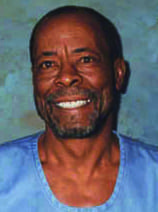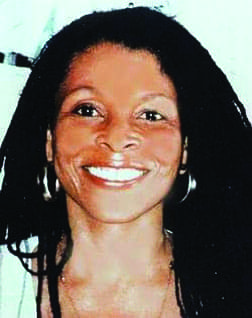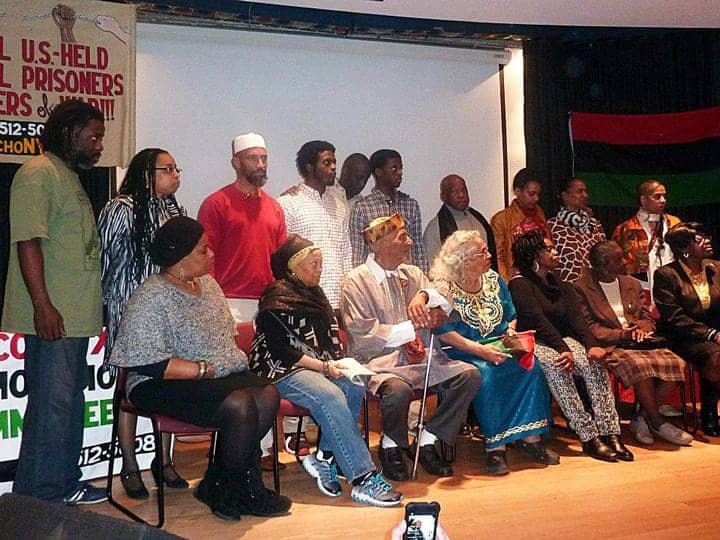by Sundiata Acoli
America has millions of prisoners locked away in its dungeons, many for 20, 30 and 40 years or more – yet astonishingly, it claims there are no political prisoners or political prisoners of war (PP/POWs) in its prisons and that it has no PPs.
That makes the U.S. the only country in the world that has MASS INCARCERATION, has more prisoners period than any other country and has prisoners locked in secret CIA prisons around the world – but no PPs.

If the U.S. has no PPs, then apparently there’s no MASS INJUSTICE in America, because that’s where MASS INCARCERATION and PPs come from. MASS INCARCERATION is the barometer, the main indicator of MASS INJUSTICE in society.
PPs are those in every land and throughout every era who are imprisoned for fighting INJUSTICE in their societies, and the same holds true today for the relationship between MASS INJUSTICE, MASS INCARCERATION and PPs in U.S. society – and who must be freed! Not only PPs, but ALL those imprisoned by unjust policies.
The latest 30-year prison-building/mass-incarceration spree has left the land dotted with thousands of new prisons overfilled with millions of prisoners – all of which has convinced state legislators that they cannot incarcerate their way out of the defects in this political system and that the current budget-busting levels of incarceration are too costly to sustain any longer.
So at this moment it seems very possible for social movements to succeed in reducing prison populations. But any reductions under the present policy would only postpone the next INCARCERATION binge to some more cost-efficient time in the future although MASS INCARCERATION itself is the problem! Not crime, not drugs nor violent offenders per se, but MASS INCARCERATION itself is the problem.
Crime rates, for serious crime, were as low in 2011 as they were in 1964. Rates for violent and nonviolent crimes have been declining for at least five years, but the national prison population is functionally the same size. So it’s clear that incarceration rates are “policy” driven, not “crime” driven. And history shows that America’s incarceration is driven primarily by unjust racial/class policies.
MASS INCARCERATION itself is the problem! Not crime, not drugs nor violent offenders per se, but MASS INCARCERATION itself is the problem. Incarceration rates are “policy” driven, not “crime” driven.
The first instance of America’s unjust racial policy occurred at inception with its incipient genocide against Indigenous Americans – theft of their land. And chattel slavery – unjust on its face – became racially so when it switched to enslaving Blacks ONLY.
Confinement of Indigenous Americans on reservations, their captured chiefs and braves in military prisons and the enslaved Afrikans on plantations for 300 years was the first MASS INCARCERATION committed by the colonial nation. Every slave confined on a plantation or runaway detained in jail was a POW. So was every Indigenous American forced onto reservations or detained in military prisons – as was any other person detained for resisting American genocide, enslavement, rape and robbery of their lands and nations.
The second instance, which began at the end of the Civil War and continued until the 1970s, was the use of Black Codes and Jim Crow segregation laws to re-enslave the newly freed Blacks and people of color in general through mass imprisonment in the penal system. At the time, Whites were the overwhelming majority of the nation’s prison population, when the percentage of Blacks in the Southern prisons jumped from near zero to 33 percent within five years.
Confinement of Indigenous Americans on reservations, their captured chiefs and braves in military prisons and the enslaved Afrikans on plantations for 300 years was the first MASS INCARCERATION committed by the colonial nation.
Others imprisoned during the ensuing 100 year struggle against Jim Crow segregation and other racial/class oppressions were the increasing number of poor immigrants and other such agricultural and industrial workers, union organizers, war resisters, ghetto heroin addicts and the rising number of Civil Rights workers and revolutionaries of all stripes – Black Panther Party, Puerto Rican Young Lords, Anti-imperialist Weather Underground Organization, Chicano Brown Berets, American Indian Movement, the Asian I WOR KUEN and numerous others – which resulted in the defeat of Jim Crow (de jure) segregation during the mid-’60s.

And the third instance of unjust racial/class policies began around 1975, a decade after the defeat of Jim Crow – legal, not actual – segregation. In that intervening period and beyond, numerous revolutionary organizations who were fighting injustice –the Black Liberation Army, FALN of Puerto Rico, American Indian Movement, Weather Underground Organization, the United Freedom Front, MOVE and others – were attacked by the police, who killed or imprisoned several of their members. Those imprisoned joined the ranks of other unrecognized PP/POWs already in prison.
Ronald Reagan set widespread injustice in motion by flooding South Central L.A. with “crack” cocaine to secretly finance the Nicaraguan Contra War in the early 1980s, and incarceration rates skyrocketed. “Crack” spread quickly, devastated ghettoes nationwide and escalated the racist, hypocritical War on Drugs and racial profiling schemes that mainly targeted people of color, White hippies and the poor as crime suspects and targeted communities of color for saturation with Street Crime Units.
The police terrorized, mass imprisoned and painted inhabitants with felony convictions later used to deny their right to vote, deny their right to work jobs or trades requiring certain licenses and certificates, deny the right to live in public housing, deny food stamps, deny student loans for college and trade course etc. That relegated felons to a permanent second-class status, exploded the prison population from 250,000 in the mid-’70s to 2.3 million today and so aptly verified noted author Michelle Alexander’s statement that “MASS INCARCERATION is the New Jim Crow.”
This era produced PP/POWs Oscar Lopez Rivera, Kuwasi Balagoon, Mumia Abu Jamal, David Gilbert, Leonard Peltier, Move 9, Susan Rosenberg, Carlos Alberto Torres, Tom Manning, Jaan Laaman and numerous Muslim, Earth Liberation Front, Animal Liberation Front, environmentalist and Occupy Wall Street PPs, plus Sekou Odinga and the liberation of Assata Shakur followed by her political asylum in Cuba.
Blacks had become the absolute majority of the prison population at about 55 percent, but the number is even higher since approximately 5 to 10 percent of the Black population is hidden in under the “Hispanic” ethnic category in the census, which often omits racial designations so that the “official” percentage of Black prisoners is listed at about 45 percent followed by a fast growing number of Browns: Latino/as, Hispanics, Indigenous Americans and Asians, with Whites declining to less than 20 percent.
The police terrorized, mass imprisoned and painted inhabitants with felony convictions later used to deny their right to vote, deny their right to work jobs or trades requiring certain licenses and certificates, deny the right to live in public housing, deny food stamps, deny student loans for college and trade course etc.
Since America’s MASS INCARCERATION is driven by unjust racial/class policies, then the real solution to MASS INCARCERATION is MASS “DECARCERATION.” In other words, drastic cuts to ALL prisoner’s TIME, since TIME is the currency, the legal tender, the great equalizer and righter of wrongs in prison.
Many prison and human rights activists are in agreement with a position forwarded by Michelle Alexander, which calls for incarceration rates to be reset to 1980 levels, or even to the post-Jim Crow level of the 1970s, which are levels before Ronald Reagan flooded South Central and set off the “crack” epidemic in America. Decarceration opens the door to struggle over the life and scope of the system more generally; it can be shrunk well beyond its earlier levels!
To “DECARCERATE,” many activists advocate some form of time-served plus prisoner-age combination that automatically put a prisoner out the door when the combination adds up to a certain number. The main proposal for this strategy, advocated by POWs like Russell Maroon Shoatz, calls for 25/50 and out: That is, if a prisoner is over 50 and has served 25 years or more, then s/he is “automatically out the door” or discharged immediately. This strategy will free those imprisoned by, or long held for, biased and unjust policies – including many PPs as well.
Since America’s MASS INCARCERATION is driven by unjust racial/class policies, then the real solution to MASS INCARCERATION is MASS “DECARCERATION.”
Thank you for your attention. I hope we can find ways to work together in support of PPs, prison struggles and progressive movements in both our countries*. Our main PP organization is The Jericho Movement at nycjericho@gmail.com. Feel free to contact them on any issue regarding solidarity work for PPs in the U.S.
I also bring you solidarity greetings from those who have been on a rolling hunger strike in the California state prisons. They’re joined in a fierce struggle to end solitary confinement; some of them have been held in solitary 20 years or more – 20 years in conditions described by their outside representative thusly:
“The long-term (indeed lifelong) indefinite isolated solitary confinement in 7’ 7” x 11’ 7” concrete boxes for 22 1/2 hours per day in California’s Pelican Bay and Corcoran Secure Housing Units (SHUS) is torture. It is cruel. Without phone calls, without human touch, degrading and humiliating routines, bad food, insufficient clothing, no fresh air and they NEVER see natural sunlight, terrible mattresses … without hope of ever escaping, all this most often for reasons that have nothing to do with behavior, or even disciplinary matters. This is unprecedented in the history of the United States. Isolated for life for alleged associations, for what books you read, what art you draw or for what you believe in. … This is commonplace in the California system – a system which takes up more than half of California’s budget.”
They’re also struggling against an insidious gang debriefing program that requires them to “give up” or “make up” info (i.e., “snitch”) on another prisoner as their only ticket out of solitary. As expected, or designed, the program creates or greatly aggravates hostility between prison gang members and ethnic groups.
In return, the hunger strike leaders have initiated a truce movement among the various gangs and ethnic groups that’s well worth your support and worth emulation by other states. To find out how you can support the California prisons’ hunger strike, contact their outside representatives at: Anne Weills and Carole Travis, Siegel and Yee, 499 14th St., Suite 300, Oakland, CA 94612, and/or contact any of the following prisoner hunger strike leaders:
- Todd Ashker, C-58191, D1-119
- Arturo Castellanos, C-17275, D1-121
- Sitawa Nantambu Jamaa (Dewberry), C-35761, D1-117
- Antonio Guillen, P-81948, D2-106
- Paul Redd, B-72683, D2-117
Pelican Bay mail to prisoners is addressed to P.O. Box 7500, Cresent City, CA 95532. Thank you.
In struggle,
Sundiata Acoli
*This article by PP/POW Sundiata Acoli was written to accompany Dan Berger, author, anarchist and college professor on his January 2013 book tour through Germany. Dan is author of “Outlaws in America: The Weather Underground Organization” and is the editor of “The Hidden ‘70s.” Send our brother some love and light: Sundiata Acoli (Squire), 39794-066, FCI Cumberland, P.O. Box 1000, Cumberland MD 21501. Sundiata, a brilliant mathematician and computer analyst, registered voters in Mississippi in 1964, joined the Black Panther Party in Harlem in 1968, and was ambushed and arrested by state troopers on the New Jersey Turnpike in 1973 with Assata Shakur and others.
Freeing political prisoners: a moral imperative of our time
by Little Red
Where do we begin to capture the raw human gravity pervading the air at the 17th Annual Dinner Tribute to Black Political Prisoners hosted by the Malcolm X Commemoration Committee last week at the MLK 1199 Labor Center in New York City?
Do we begin with the obvious room full of emotion for men and women who are now virtually unknown to the communities they sacrificed their lives for? Or the haunting litany of the time served by the longest held political prisoners on the evening’s program, a list approaching 900 years! … 900 years!

Perhaps Dequi Sadiki, the evening’s moderator, the organization’s leader and wife of political prisoner Sekou Odinga, said it best when she said emotionally, “For these families, with the loss of fathers, mothers, grandfathers, grandmothers, uncles, aunts, sons and daughters who were guilty of nothing more than standing up for our people, all this time we are talking about here, for them, this is all too real and all real personal.”
Make no mistake about it, the Malcolm X Commemoration Committee does a heartwrenching, monumental job of bringing together much deserved love and appreciation for America’s political prisoners, primarily Black men and women who were targeted by the FBI Cointelpro Operations and by local and state police forces obsessed with crippling the Black Liberation Movement.
For all of the emotional gravity in the room, the night was incredibly uplifting and the energy amazingly uptempo. Pittsburgh based progressive emcee Jasiri X may have had a lot to do with that. His performance of his antiracist and anti-police brutality classics – “Trayvon,” “Do We Have to Start a Riot?” “I Am Troy Davis” – got the intergenerational audience on its feet.
Scholar-activist Johanna Fernandez’ presentation brought the motion of the evening together. Explaining the factors that linked the repression facing the political prisoners to what is now being called mass incarceration, Fernandez looked at some of the legal tools put in place some time ago to create this current condition.
Johanna Fernandez finished by daring to say that “creating a movement to free political prisoners is the moral imperative of this time.”
She pointed to an underappreciated federal law, the Omnibus Crime Bill of 1968, which essentially exempted the police, as a national institution, from the due process accountability that came with the Civil Rights Act of 1964 and the Voting Rights Act of 1965. With this exemption, police agencies across the country began a steady push of excessive force and criminalizing the Black community.
“She hit the nail on the head,” said Zayid Muhammad, the committee’s longtime press officer. “Combine that with their angrily embarrassing loss of the Panther 21 case here in New York from which sprang Operation NewKill, a wider wage of covert actions aimed just against the Black Panther Party in this area, and you will understand plainly why we here today,” he finished emphatically.
Although professorial in tone, Fernandez was definitely telling the audience to seize the time when she said that “we need to look at these next four years,” referring to President Obama’s second term, the way the Puerto Rican Independence Movement looked at the last four years of the Clinton administration. They pulled out all stops and were able to secure the release of the majority of their freedom fighters through clemency, but only after a long, steady lobbying and protest strategy. The same thing needs to be done now for these freedom fighters.
She finished by daring to say that “creating a movement to free political prisoners is the moral imperative of this time.”
Contact the writer via Zayid Muhammad at babazayid@yahoo.com.





